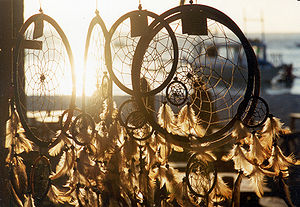- Dreamcatcher
-
- This is about the traditional Native American object. For other uses, see Dreamcatcher (disambiguation).
In Ojibwe (Chippewa) culture, a dreamcatcher (or dream catcher; Ojibwe asabikeshiinh, the inanimate form of the word for "spider"[1][2] or bawaajige nagwaagan meaning "dream snare"[2]) is a handmade object based on a willow hoop, on which is woven a loose net or web. The dreamcatcher is then decorated with personal and sacred items such as feathers and beads.
Contents
Origin
While dreamcatchers originated in the Ojibwa Nation, during the Pan-Indian Movement of the 1960s and 1970s they were adopted by Native Americans of a number of different nations. Some consider the dream catcher a symbol of unity among the various Indian Nations, and a general symbol of identification with Native American or First Nations cultures. However, other Native Americans have come to see dream catchers as over-commercialized.[3] Non-Indians have also used the dreamcatcher for their own purposes.
American ethnographer Frances Densmore writes in her book Chippewa Customs (1979, pg. 113):
Even infants were provided with protective charms. Examples of these are the "spiderwebs" hung on the hoop of a cradle board. These articles consisted of wooden hoops about 3½ inches in diameter filled with an imitation of a spider's web made of fine yarn, usually dyed red. In old times this netting was made of nettle fiber. Two spider webs were usually hung on the hoop, and it was said that they "caught any harm that might be in the air as a spider's web catches and holds whatever comes in contact with it."
Traditionally, the Ojibwa construct dreamcatchers by tying sinew strands in a web around a small round or tear-shaped frame of willow (in a way roughly similar to their method for making snowshoe webbing). The resulting "dream-catcher", hung above the bed, is used as a charm to protect sleeping children from nightmares. As dreamcatchers are made of willow and sinew, they are not meant to last forever but are intended to dry out and collapse as the child enters the age of wonderment.[citation needed]
The Ojibwa believe that a dreamcatcher changes a person's dreams. According to Konrad J. Kaweczynski, "Only good dreams would be allowed to filter through… Bad dreams would stay in the net, disappearing with the light of day."[4] Good dreams would pass through and slide down the feathers to the sleeper.
Another version from the same article was, "Nightmares pass through the holes and out of the window. The good dreams are trapped in the web, and then slide down the feathers to the sleeping person."[4]
Popularization
In the course of becoming popular outside of the Ojibwa Nation, and then outside of the pan-Indian communities, "dreamcatchers" are now made, exhibited, and sold by some New age groups and individuals. According to Philip Jenkins, this is considered by most traditional Native peoples and their supporters to be an undesirable form of cultural appropriation.[5]
The official portrait of Ralph Klein, former Premier of the Canadian province of Alberta and whose wife Colleen Klein is Métis, incorporates a dreamcatcher.[6]
The idea of a dream catcher was used by Margaret Salinger, daughter of J. D. Salinger, in her book of memoirs about her father, Dream Catcher: A Memoir.
See also
References
- ^ Freelang Ojibwe Dictionary
- ^ a b Prindle, Tara. "NativeTech: Dream Catchers". http://www.nativetech.org/dreamcat/dreamcat.html. Retrieved September 23, 2007.
- ^ "Native American Dream catchers", Native-Languages
- ^ a b Terri J. Andrews, "Living by the Dream", World & I, Nov. 1998, p. 204
- ^ Jenkins, Philip (September 2004). Dream Catchers: How Mainstream America Discovered Native Spirituality. New York: Oxford University Press. ISBN 0195161157.
- ^ "Ralph Klein breaks tradition in legislature portrait". Canadian Broadcasting Corporation. 2007-08-31. http://www.cbc.ca/canada/edmonton/story/2007/08/30/klein-portrait.html?ref=rss.
External links
Categories:- Anishinaabe mythology
- Native American culture
- Native American art
- American Indian relics
- First Nations culture
- Lucky symbols
Wikimedia Foundation. 2010.


